Hi JAG,
Post #618: "... OP hasn't updated us with his new design for eight 18s yet, but if you compare his original design (the 32000 liter horn with 5x 12 inch drivers) with a stack of 8 Labhorns, the Labs blow it out of the water. OP's 20 hz horn will obviously go a bit lower in frequency but the Labs are much louder."
Eight Labhorns contain 16 LAB12 drivers, low frequency extension is a level killer... Not a proper comparison, and, the OP's stated goal is to hear something that otherwise does not exist. Now, we might be able to come up w/ something smaller and louder, but that is not what he wants.
Regards,
Post #618: "... OP hasn't updated us with his new design for eight 18s yet, but if you compare his original design (the 32000 liter horn with 5x 12 inch drivers) with a stack of 8 Labhorns, the Labs blow it out of the water. OP's 20 hz horn will obviously go a bit lower in frequency but the Labs are much louder."
Eight Labhorns contain 16 LAB12 drivers, low frequency extension is a level killer... Not a proper comparison, and, the OP's stated goal is to hear something that otherwise does not exist. Now, we might be able to come up w/ something smaller and louder, but that is not what he wants.
Regards,
Eight Labhorns contain 16 LAB12 drivers, low frequency extension is a level killer... Not a proper comparison ...
Regards,
For matters of comparison and perspective it's a fine comparison. Both systems have their pros and cons.
For example, the Lab stack is about 27000 liters smaller, it's portable and it's a lot cheaper and less work to make.
27000 extra liters can buy you a lot of low frequency extension.
I just showed a well known example to compare OP's horn against, obviously they are different but they can be compared. Goals and priorities will dictate which is "better", I was just providing some context about the comments about OP's horn being "too good".
Hi JAG,
Post #614: "...It's going to be very difficult to actually build an Nd horn with a 4:1 compression ratio."
I hope you don't think I'm picking on you, you have contributed a lot of interesting and valid contents in this thread.
But 🙂 , the OP has talked about the possiblility of using wood or metal for the throat section. I'll attach another one of my doodles to show how "easy" it is to come up w/ a Nd throat arrangement for this straight horn. Now, if you want a single throat for all drivers you'll have to deal w/ phase plugs, and adapters, that's why I showed the link to Realhorns in Post #21. Either way, we don't even know which driver the OP will finally pick.
Regards,
Post #614: "...It's going to be very difficult to actually build an Nd horn with a 4:1 compression ratio."
I hope you don't think I'm picking on you, you have contributed a lot of interesting and valid contents in this thread.
But 🙂 , the OP has talked about the possiblility of using wood or metal for the throat section. I'll attach another one of my doodles to show how "easy" it is to come up w/ a Nd throat arrangement for this straight horn. Now, if you want a single throat for all drivers you'll have to deal w/ phase plugs, and adapters, that's why I showed the link to Realhorns in Post #21. Either way, we don't even know which driver the OP will finally pick.
Regards,
Attachments
The Lab example reminded me of something that I should have mentioned a long time ago. You can clearly see the Lab doesn't and never was intended to have very high frequency capability. There's a very good reason for that - it was designed to have a small gain bandwidth because it's a subwoofer. That's exactly why the Lab 12 drivers do not have particularly low Mms, high Bl or low Qts.
OP is still looking for drivers with low Mms, high Bl and low Qts for this subwoofer because some 1970s papers said those types of drivers are good for horns. So let's look at why the papers say that.
One of the first calculations for any design should be the required bandwidth that the drivers have to produce.
These are the formulas for the low frequency limit and the high frequency limit.
Fl = (Qts x fs) / 2
Fh = (2 x fs) / Qts
If you look at the Fh formula (the upper frequency limit of the driver) and you understand what physical qualities affect fs and qts, it's very clear to see that low Mms, high Bl, high qts drivers can have a very extended bandwidth and play up to very high frequencies compared to drivers with different specs.
This is exactly why the early horn papers suggested those types of driver, it was all about extended bandwidth and nothing else.
Clearly, when looking at OP's horn sim the papers are right, this type of driver provides incredibly extended high frequency bandwidth.
Also very clear is that Danley chose an entirely different type of driver for the Labhorn because extended high frequency bandwidth is not a good goal for a subwoofer, a driver with a more limited gain bandwidth is a much better idea. (The original math suggested a driver that had even less gain bandwidth than the Lab 12 ended up with.)
So the 1970s papers driver spec recommendations were all about extended bandwidth, that particular spec combo is not ideal for any other purpose. And since this is a sub project and it's never going to play anywhere near 300 hz anyway, picking drivers with that spec combo is a bit inappropriate.
If you read the horn math papers and work through the equations it's becomes a lot more clear why certain things were recommended, and sometimes these recommendations have nothing at all to do with a given project.
OP is still looking for drivers with low Mms, high Bl and low Qts for this subwoofer because some 1970s papers said those types of drivers are good for horns. So let's look at why the papers say that.
One of the first calculations for any design should be the required bandwidth that the drivers have to produce.
These are the formulas for the low frequency limit and the high frequency limit.
Fl = (Qts x fs) / 2
Fh = (2 x fs) / Qts
If you look at the Fh formula (the upper frequency limit of the driver) and you understand what physical qualities affect fs and qts, it's very clear to see that low Mms, high Bl, high qts drivers can have a very extended bandwidth and play up to very high frequencies compared to drivers with different specs.
This is exactly why the early horn papers suggested those types of driver, it was all about extended bandwidth and nothing else.
Clearly, when looking at OP's horn sim the papers are right, this type of driver provides incredibly extended high frequency bandwidth.
Also very clear is that Danley chose an entirely different type of driver for the Labhorn because extended high frequency bandwidth is not a good goal for a subwoofer, a driver with a more limited gain bandwidth is a much better idea. (The original math suggested a driver that had even less gain bandwidth than the Lab 12 ended up with.)
So the 1970s papers driver spec recommendations were all about extended bandwidth, that particular spec combo is not ideal for any other purpose. And since this is a sub project and it's never going to play anywhere near 300 hz anyway, picking drivers with that spec combo is a bit inappropriate.
If you read the horn math papers and work through the equations it's becomes a lot more clear why certain things were recommended, and sometimes these recommendations have nothing at all to do with a given project.
Hi JAG,
Post #614: "...It's going to be very difficult to actually build an Nd horn with a 4:1 compression ratio."
I hope you don't think I'm picking on you, you have contributed a lot of interesting and valid contents in this thread.
But 🙂 , the OP has talked about the possiblility of using wood or metal for the throat section. I'll attach another one of my doodles to show how "easy" it is to come up w/ a Nd throat arrangement for this straight horn. Now, if you want a single throat for all drivers you'll have to deal w/ phase plugs, and adapters, that's why I showed the link to Realhorns in Post #21. Either way, we don't even know which driver the OP will finally pick.
Regards,
That's certainly one way to do it, although I wouldn't call it easy by any means. Theres a lot easier ways to do it, although your suggestion is very elegant and eliminates any large area steps or reflective boundaries.
It's a lot easier just to cluster the drivers around the closed end as per all our previous discussions on this matter in this thread, and since a goal of extension to 300 hz is (IMO) a very bad idea, the notch that the offset driver provides doesn't matter.
To keep from getting all out of hand, good to separate the urge to make a horn that goes low (32 Hz as a broad design target would be more than low enough) and urge to be loud. Where things get screwy is when astronomic power levels seem to be coming out of the sim sausage maker based on ill-considered geometries.
We're reading mindless boys-with-toys instead of creative design; lots of unwise judgments based on rock concert experience mis-applied to a home or virginal sim-players who lack the judgment to critique their black-box sim results.
So what I'm saying is re-examine assumptions, particularly how you can fashion a geometry that doesn't require inconceivable power level and unmanageable costs.... and still uses a big horn.
BTW, I have my own hopes. Corresponding to the ill-fated useless church organ thread*, I hope to see a project suitably finished and measured. So we can all learn something here.
Ben
*I wouldn't be surprised if the final result was poor, but despite all the effort made on this forum to help, nobody is measuring the sound in the pews.
We're reading mindless boys-with-toys instead of creative design; lots of unwise judgments based on rock concert experience mis-applied to a home or virginal sim-players who lack the judgment to critique their black-box sim results.
So what I'm saying is re-examine assumptions, particularly how you can fashion a geometry that doesn't require inconceivable power level and unmanageable costs.... and still uses a big horn.
BTW, I have my own hopes. Corresponding to the ill-fated useless church organ thread*, I hope to see a project suitably finished and measured. So we can all learn something here.
Ben
*I wouldn't be surprised if the final result was poor, but despite all the effort made on this forum to help, nobody is measuring the sound in the pews.
Last edited:
To keep from getting all out of hand, good to separate the urge to make a horn that goes low (32 Hz as a broad design target would be more than low enough) and urge to be loud.
As usual, your advice is for the OP to change his goals. I wondered how long it was going to take you to suggest OP can't even pick his own goals properly, as you usually do.
Where things get screwy is when astronomic power levels seem to be coming out of the sim sausage maker based on ill-considered geometries.
We're reading mindless boys-with-toys instead of creative design; lots of unwise judgments based on rock concert experience mis-applied to a home or virginal sim-players who lack the judgment to critique their black-box sim results.
You know what would be a whole lot more useful and actually indicate you had any idea what you are talking about? Show us the errors in the data that's been presented and suggest an alternative.
Everyone knows the sims are pretty accurate at small signal levels and lose accuracy at very high power levels due to non linearities when approaching the driver's limits. This is well known and the people that use these sim tools know what's going to happen, how to predict it and what the effect is going to be.
WRT OP's original horn sim, each driver was getting probably under 100 watts each at xmax, only a small fraction of the driver's rated power handling, so thermal considerations are moot. The compression ratio is low enough to provide adequate flow characteristics through the throat, so distortion is (almost) moot. And there were no problems with the flare itself. So the only problem is the non linear Bl, Cms and Le curve nearing and exceeding rated excursion limits, and we know exactly what effect that has.
So please educate us poor fools on what we are doing so wrong.
Let's remember that you are the only one in this discussion that has outright admitted that you have no idea how to design or evaluate a horn.
As usual, all you can offer is a naive criticism of things you don't even understand. And since you don't understand it all you can do is make passive aggressive personal insults instead of a solid technical argument. Mindless boys with toys? Virginal sim players? Really Ben? Is that the best you can do? At least take some responsibility, download and try a simulator and try to understand what it's telling you. Read some audio theory and attempt to follow the discussion in an intelligent fashion. The personal insults are fun and amusing but it shows very clearly that you are unable to form any kind of coherent technical argument.
If you want to talk about the church organ thread, if you recall the OP's goal was ONLY to get more 16 hz spl. Your suggestion was to abandon that goal (the only stated goal), put a small leak in his sealed subwoofer and add a Klipschhorn to the system, none of which would help the output at 16 hz. With every step that OP took while following the advice of people that actually knew what they were talking about and how things work, OP expressed great strides in the direction of his goal. It's too bad that OP never finished up and provided measurements for us, but those of us that know basic audio theory know he was headed in the right direction. If he had taken any of your advice at all he would have spent quite a bit of money and been very disappointed.
Last edited:
This "tread" continues to amuse me - - - Christ on a Stick, you are just not listening, and have not listened to the problems associated with large scale audio reproduction.
Weltersys, my current plan is to cross my "mono" bass horn (with a 10-foot x 22.5-foot mouth) around 80 Hz. And have stereo horns (positioned just adjacent to the bass horn mouth) covering the rest of the spectrum. I’m assuming by the condescending tone of your comment, that you do not agree with my current plan. Please - what would you recommend I do differently? FWIW, the 300 Hz crossover point was not my idea, and my plan to build 80 Hz stereo mid-bass horns, sorta implies that I'm skeptical of a 300 Hz crossover point also. . . .
To all - the goal of this project is effortless sound reproduction, deep into the bottom octave. But more importantly, I’m excited to actually build something that I’ve only read about in books. Another important design objective is to place this system outside (in the harsh Washington State weather) - burry it half underground, and leave the horn exposed to the elements for 50 years. Lastly, if (qty 5) 12” drivers sound absolutely fabulous (and only hit 135 dB), whereas (qty 8) 18s sound less than simply fabulous, but play much louder – I will be reinstalling the (qty 5) 12” drivers. Reason: SPL is important, but sound quality remains the dominant design factor (and I'm only feeding sound to a portion of my backyard - not an arena sitting 103,000 people.. . .)
See below: my horn is going to have an adjustable throat. The eight 18s would be the bottom example (not to scale) loading the large concrete throat opening. The five 12s would be the top example (not to scale), loading a smaller wooden throat & wooden horn extension. And obviously there are design options between. The backside of the horn is going to be contained in a small outbuilding (protecting it from the elements). The electronics will also be in the outbuilding. I will be fabricating more than one driver iteration – starting with (qty 5) 12s, and then (qty 8) 18s - and I will listen to see which one sounds best. The only design aspect that is actually set-in-stone (pun intended) is the concrete portion of the bass horn design.
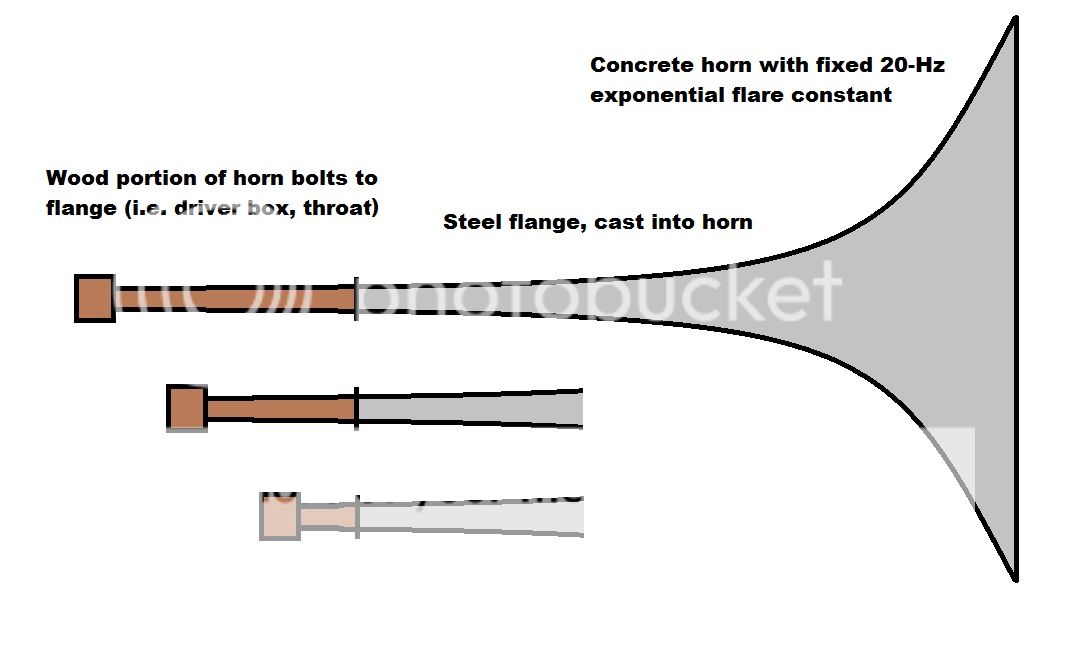
Last edited:
Hi Entropy455,
Here is an indoor example that shows a few interesting techniques...
Regards,
Here is an indoor example that shows a few interesting techniques...
Regards,
Attachments
-
 Euterpe_The Horn at_Intro.JPG216.4 KB · Views: 123
Euterpe_The Horn at_Intro.JPG216.4 KB · Views: 123 -
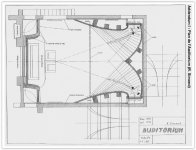 Euterpe_The Horn at_plan.JPG268 KB · Views: 131
Euterpe_The Horn at_plan.JPG268 KB · Views: 131 -
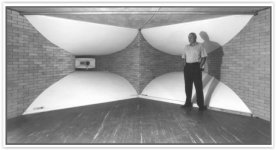 Euterpe_The Horn at_front.JPG143.9 KB · Views: 128
Euterpe_The Horn at_front.JPG143.9 KB · Views: 128 -
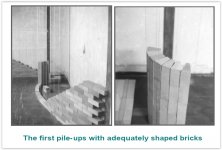 Euterpe_The Horn at_bricks.JPG202 KB · Views: 128
Euterpe_The Horn at_bricks.JPG202 KB · Views: 128 -
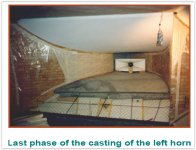 Euterpe_The Horn at_casting.JPG298.9 KB · Views: 91
Euterpe_The Horn at_casting.JPG298.9 KB · Views: 91 -
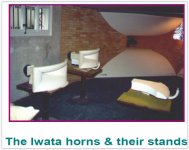 Euterpe_The Horn at_Iwatas.JPG241 KB · Views: 100
Euterpe_The Horn at_Iwatas.JPG241 KB · Views: 100 -
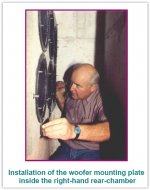 Euterpe_The Horn at_drivers.JPG141 KB · Views: 101
Euterpe_The Horn at_drivers.JPG141 KB · Views: 101
Wrong is a relative term. We are insensitive to small timing differences in the low octaves, reflections proper, diffraction and direction, compared to more critical higher bands, except where the response is affected.So please educate us poor fools on what we are doing so wrong.
Otherwise known as, how to traverse most of the deadly sins in one project 😀 A hyp-ex horn isn't perfect, not that it has to be. This reputation is based on size. Maybe someone should build a 30 degree bass waveguide 😉A straight full size 20 Hz horn, or half of one on the ground, is one of the holy grails of audio possession.
Those small differences in timing in the low octaves are responsible for 20 db dips in response at certain frequencies. Did you see the frequency response charts Bob posted? This means that in certain areas certain bass notes are going to be completely missing. Don't include me in your "we are insensitive" comment, I'm very sensitive to missing bass notes.
Sorry my post was TL;DR.except where the response is affected.
Sorry my post was TL;DR.
Not sure what this means, the response is affected everywhere except directly on axis. As soon as you get 1 degree off axis the response is affected.
I'm not even sure what point you are trying to make. If you have something to say, please point out the exact issue you are talking about and how you propose to fix it or at least why it doesn't matter (just saying it doesn't matter doesn't count, provide some evidence - I've showed a ton of info here, I expect a bit of technical info if you want to make a rebuttal.)
Right.Wrong is a relative term. We are insensitive to small timing differences in the low octaves, reflections proper, diffraction and direction, compared to more critical higher bands, except where the response is affected.
And to add comb filtering and multi-speaker interference lobes can't be heard except conceptually, but they do make dramatic pictures in textbooks and when posted by compulsive but ill-informed show-offs. That's why it is nonsense to say the sound person walks around the stadium and hears interference lobes when the band practices ("gosh, I'm absolutely certain the 3rd fret on the second string on the guitar should be a hair louder in seat 44F").... he or she would be lucky to detect a blown tweeter walking around a live stadium, even if they could hear above 7kHz.
Ben
Last edited:
Eric,1) My bass horn could do surprisingly well up to 300 Hz (I don't know - I've never heard one before.)
2)The reason I want kick horns, is because I will lose all stereo separation in the business end of my music (80 to 300 Hz), if I cross my bass horn at 300 Hz. Even if I cross at 160 Hz, I'll still lose an entire octave of "kick" stereo separation. Is this really a problem?
3) I don't know. I am a little disappointed that my "no-compromise" horn system will ultimately be loaded with compromise.
4)My thought was that I'd build my mono bass horn out of concrete, then I'd build some 80 Hz stereo mid-bass horns out of wood, and simply listen to it. Adjusting the crossover frequency is a simple electronic adjustment. Believe me - if a crossover point of 300 Hz sounds best, that is absolutely where I will set the system.
5)I fully anticipate having to construct several iterations of mid-bass horns before I find the sound I'm happy with. If I only need 160 Hz mid-bass horns, that's all the larger I'm going to build them. .
_____________________________________________________________________________
Weltersys replied:
Eric,
1)Yes it could. Do you want to hear the low end of vocals and instruments "walk" with their pitch (frequency/note) around your bass horn and upper reproducers located in different L/R directions? I certainly would not.
2) You are not listening, and have not listened to the problems associated with large scale audio reproduction. I have, in hundreds of indoor and outdoor venues of every conceivable configuration, with horn systems from every major sound company, in iterations spanning 5 decades of designs.
3) Welcome to the real world.
4) "Sounds Best" for what genre? See response #2, for the real sh#t.
5) Good for you, if you construct several iterations of mid-bass horns before you find the sound you are happy with, and do it at the rate of folks that actually get paid for what they do, you could achieve your goals in another decade or so, if you are able to separate the wheat from the chaff .
_____________________________________________________________________
A)Weltersys, my current plan is to cross my "mono" bass horn (with a 10-foot x 22.5-foot mouth) around 80 Hz. And have stereo horns (positioned just adjacent to the bass horn mouth) covering the rest of the spectrum. I’m assuming by the condescending tone of your comment, that you do not agree with my current plan. Please - what would you recommend I do differently?
B)FWIW, the 300 Hz crossover point was not my idea, and my plan to build 80 Hz stereo mid-bass horns, sorta implies that I'm skeptical of a 300 Hz crossover point also. . . .
C)To all - the goal of this project is effortless sound reproduction, deep into the bottom octave. But more importantly, I’m excited to actually build something that I’ve only read about in books.
D)Another important design objective is to place this system outside (in the harsh Washington State weather) - burry it half underground, and leave the horn exposed to the elements for 50 years.
E)Lastly, if (qty 5) 12” drivers sound absolutely fabulous (and only hit 135 dB), whereas (qty 8) 18s sound less than simply fabulous, but play much louder – I will be reinstalling the (qty 5) 12” drivers. Reason: SPL is important, but sound quality remains the dominant design factor (and I'm only feeding sound to a portion of my backyard - not an arena sitting 103,000 people.. . .)
F)See below: my horn is going to have an adjustable throat. The eight 18s would be the bottom example (not to scale) loading the large concrete throat opening. The five 12s would be the top example (not to scale), loading a smaller wooden throat & wooden horn extension.
G)The only design aspect that is actually set-in-stone (pun intended) is the concrete portion of the bass horn design.
Sorry if my tone was condescending in my last post, it was late, and I was rather drunk, a writing practice I have generally avoided after writing stuff in the last part of last century and early part of this century I later read and regretted.
A) You have ignored or rejected several suggestions I have already given you regarding what would be better based on my listening to systems with the built-in mistakes you seem to want to experiment with.
Consider your lack of answer to my reply #1 above, or most of any of my prior questions designed to focus your efforts into productive work.
Consider you are embarking on an expensive project without paying for professional help, akin to me embarking on the design of a nuclear submarine dock station without consulting designers that have lived in, operated and designed them.
B) Back in the 1970's dinosaur days of the introduction of rock and roll's "bastard son" contribution to sound systems, the mid-bass horn, it was common to cross said devices in the 300-1200 Hz range. See reply #1.
C) I understand, years before I built my first fully horn loaded systems back in the early 1970s, I had only read about them in books and heard them in auditoriums, and was exited to have a system of my own. That said, in the decades have intervened, as new design approaches, transducers, amplification, and DSP have become available, my excitement is in the "wow" factor you are looking for, the "effortless sound reproduction, deep into the bottom octave" (which you have not defined-1 to 2 Hz could be considered the bottom octave in whole numbers, while for all practical musical intents, 25 Hz is the "bottom octave" of pop music) using whatever achieves those goals with the minimum cost and effort to produce. I pick the right tools for the job, and get paid to do that, like you do in your day job.
D) As stated about half a dozen times before, concrete is not the only 50 year survivable material, but if you require that aesthetic, no arguments here, other than you are choosing to undertake far more work and expense than is required to meet your sonic goals.
E) I have heard "fabulous" bass horns using every size driver from 8" to 21", and awful sounding bass horns using the same frame sizes.
F) Why not have them feed the same horn? Oh, right, you have committed to a mono bass source and a single listening position. Never mind.
G) See "F", which is what happens when one does not integrate system design from a synergetic paradigm.
Buckminister Fuller's Synergetics book, and 1979's Synergetics book 2, as well as many of his earlier works, and Victor Papenek's "Design For The Real World" are is deeply embedded in my design approach as the many audio "bibles" I have consumed as they became available. Although learning from books is a great thing, field experience with what works and what sucks, what sounds great, and what sounds so-so, what lasts and what breaks down, and what matters to whom can't easily be learned, they must be earned.
Art
Last edited:
Ben,...it is nonsense to say the sound person walks around the stadium and hears interference lobes when the band practices ("gosh, I'm absolutely certain the 3rd fret on the second string on the guitar should be a hair louder in seat 44F").... he or she would be lucky to detect a blown tweeter walking around a live stadium, even if they could hear above 7kHz.
Although I suffer NIHL at 4kHz, I can still easily hear an octave above 7 kHz, and can detect a single dragging voice coil in a system with hundreds of drivers, given the right program material.
Given any wide band source- live or recorded music, or pink noise, I can easily detect interference lobes and room nodes and modes while walking a venue of any size from a domestic living room, a 50,000 seat arena, or an outdoor show covering 40 acres.
Given that my hearing is by no means "golden", and given the fact that I personally have worked with literally hundreds of technicians that can easily detect the same things as I, you simply should understand that your claim that detecting those requires "luck" is bullcrap, it only requires a bit of training.
Having trained dozens of audio engineers that have continued to use that training (those who are still alive, RIP Tom McKean & Monte Lee Wilkes) to good effect in the ensuing decades, I have never found learning the skills to detect sound system problems to be difficult for any person of reasonable intelligence and hearing in the "normal" range. The gun-shooting guy who taught me many of the audio skills could not hear above 7kHz, and probably had more severe NIHL than me, he could not hear a phone ringing if it it was not in the same room.
I could probably teach you the skills too, Ben, but you'd have to pay a lot to get me back to Canada 😉 .
Cheers,
Art
Last edited:
A) You have ignored or rejected several suggestions I have already given you regarding what would be better based on my listening to systems with the built-in mistakes you seem to want to experiment with.
Consider your lack of answer to my reply #1 above, or most of any of my prior questions designed to focus your efforts into productive work.
He did very clearly answer #1. He plans to cross over at 80 hz, with whatever filter slope is necessary. If you think the pitch and tone are going to be walking around with a crossover like that I guess that's your opinion.
Consider you are embarking on an expensive project without paying for professional help ...
Again with this? I've been following pretty closely and even I don't know exactly what your recommendations are, the only thing I'm reading loud and clear from you is "Please give me money." Apart from that your answers (like the one posted last night) are incredibly cryptic and condescending. No detail, lots of attitude.
Oh, right, you have committed to a mono bass source and a single listening position. Never mind.
I guess this is as close as we are going to get to a straight answer from you without paying for it. It looks like you are still recommending dual subs.
This doesn't make any sense. Single or dual sub, you can't get the mains any closer to the sub than OP is proposing unless you put the mains INSIDE the subs, which you have not been recommending lately (you said to put the mains in the barn doors).
Your solution (whatever it is) can't be any better than what has been proposed, as it doesn't get the mains any closer to the sub(s) than they already are so you can't possibly fix the non existent tone and pitch walking and with the dual subs you introduce a minefield of hot spots and nulls everywhere except directly on axis.
Although learning from books is a great thing, field experience with what works and what sucks, what sounds great, and what sounds so-so, what lasts and what breaks down, and what matters to whom can't easily be learned, they must be earned.
Art
This is especially ironic, really the cherry on top. You've never studied full size horns and very likely haven't ever heard anything even close to the intent of this project. So what field experience do you have that directly relates to this project that anyone else here doesn't have?
I complimented you before on your prolific experience and career, but you don't have any experience at all with a 32000 liter bass horn (not to mention dual 32000 liter bass horns) so quit referencing your experience and asking for money.
A circle no more begins at 0 degrees than 214.5 degrees, why is on axis any different? Destructive interference and lobing is everywhere, only the depth varies.everywhere except directly on axis.
Some fishing after the fact. All quotes from this site (Gedlee chosen as he is qualified and careful with his facts). Disclaimer: context.I expect a bit of technical info
Gedlee said:There are always compromises, but not all compromises are equal.
A reflection could influence the frequency response at the listening position, but not the imaging. However, if you look at the effect of a reflection below 700 Hz it is not very large. Not at all like it is above 700 Hz.
on image perception. In most of the literature, say from Blauert and the like, they do not even look below about 500 Hz.
Griesinger would argue against this position stating that the fundamental is far less important than > 700 Hz and doesn't really have to "work together" with the upper harmonics.
there is no "good" crossover, only lessor bad ones. Lobing will always occur in non-coincident drivers and coincident ones have there own set of problems. The higher the frequency the bigger the problems. So if one can be avoided above 1 kHz it is best to do so.
There will always be a null with non-coincident drivers at some vertical angle. At very low crossover frequencies this null can be beyond 180 degrees. As the crossover frequency goes up this null will move forward in angle and in fact more nulls can begin to appear. Hence the lower the crossover the less of an effect this hole is likely to be.
weighting phase below 700 Hz as high is not reasonable
These functions get vanishing small below 700 Hz. Nothing at all compared to > 700 Hz.
* [On interaural time/level differences]
We localize only on sounds > 700 Hz. so very early reflections < 700 Hz do not cause image problems.
where this discussion started. Its not about the virtual source location played by two speakers, it about the image shift that results from reflections below 700 Hz. I maintain that this region is not a significant factor. I stand by that comment.
From 200 Hz to 700 Hz there is some coloration potential from a strong reflection, but probably no image location implications. Below 200 Hz is all steady state and this is dealt with by EQ of multiple sources hence no coloration of imaging effects should be expected.
Next would be the control of the early reflections through directivity. The directivity has to be below 90 degrees or the side walls will get too much sound. this should be done down to about 700 Hz below which this factor becomes less important.
Last edited:
1) My bass horn could do surprisingly well up to 300 Hz (I don't know - I've never heard one before.)
2)The reason I want kick horns, is because I will lose all stereo separation in the business end of my music (80 to 300 Hz), if I cross my bass horn at 300 Hz. Even if I cross at 160 Hz, I'll still lose an entire octave of "kick" stereo separation. Is this really a problem?
___________________________
1)Yes it could. Do you want to hear the low end of vocals and instruments "walk" with their pitch (frequency/note) around your bass horn and upper reproducers located in different L/R directions? I certainly would not.
2) You are not listening, and have not listened to the problems associated with large scale audio reproduction. I have, in hundreds of indoor and outdoor venues of every conceivable configuration, with horn systems from every major sound company, in iterations spanning 5 decades of designs.
Eric,
B) Back in the 1970's dinosaur days of the introduction of rock and roll's "bastard son" contribution to sound systems, the mid-bass horn, it was common to cross said devices in the 300-1200 Hz range. See reply #1.
Art, I'm sorry if I bother you with this, but I'm curious and want to know what exactly you are suggesting with these statements.
Are you suggesting that there will be localization problems if the crossover between subwoofer and mains is too high, e.g.200 or 300 Hz? Would one be worse than the other?
It's probably just me, but I have a hard time precisely understanding some of your statements. Some of them appear rather ambiguous to me, only hinting at things instead of stating your point clearly.
@JAG: come on man, I don't think Art deserves such a flogging....
- Home
- Loudspeakers
- Subwoofers
- Concrete Bass Horn Design Question